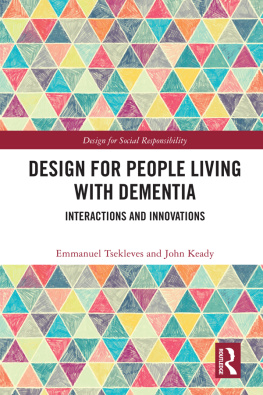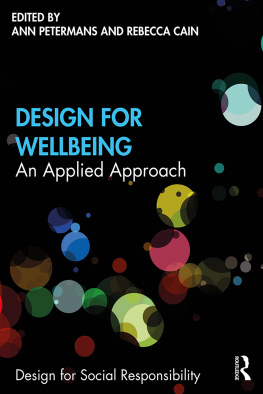Design for People Living with Dementia
There were an estimated 50 million people worldwide living with dementia in 2017 and this number will almost double every 20 years, reaching 82 million in 2030. Design has significant potential to contribute to managing this global concern. This book is the first to synthesise the considerable research and projects in dementia and design. Design interactions is a new way of considering how we can improve the relationship between people, products, places and services and of course technology trends, such as the internet of things, offer great opportunities in providing new ways to connect people with services and products that can contribute to healthier lifestyles and mechanisms to support people with acute and chronic conditions. In light of this, the book explores the contribution and future potential of design for dementia through the lens of design interactions, such as people, contexts, material and things.
Design for People Living with Dementia is a guide to this innovative and cutting-edge field in healthcare. This book is essential reading for healthcare managers working to provide products, services and care to people with dementia, as well as design researchers and students.
Emmanuel Tsekleves is Senior Lecturer in Design Interactions at Imagination Lancaster, Lancaster University, UK. Emmanuel leads research at the intersection of design, health, well-being and technology. His design-led research attracted media attention by the national press, such as the Daily Mail, Daily Mirror, The Times, Discovery News and several other international online media outlets. He blogs regularly for The Guardian and The Conversation on the design and use of technology in health.
John Keady is Professor of Older Peoples Mental Health, leading the interdisciplinary Dementia and Ageing Research Team at the University of Manchester, UK.
Design for Social Responsibility
Series editor: Rachel Cooper
Social responsibility, in various disguises, has been a recurring theme in design for many years. Since the 1960s several more or less commercial approaches have evolved. In the 1970s designers were encouraged to abandon design for profit in favour of a more compassionate approach inspired by Papanek. In the 1980s and 1990s, profit and ethical issues were no longer considered mutually exclusive and more market-oriented concepts emerged, such as the green consumer and ethical investment. The purchase of socially responsible, ethical products and services has been stimulated by the dissemination of research into sustainability issues in consumer publications. Accessibility and inclusivity have also attracted a great deal of design interest and recently designers have turned to solving social and crime-related problems. Organisations supporting and funding such projects have recently included the NHS (research into design for patient safety); the Home Office has (design against crime); Engineering and Physical Sciences Research Council (design decision-making for urban sustainability).
Businesses are encouraged (and increasingly forced by legislation) to set their own socially responsible agendas that depend on design to be realised. Design decisions all have environmental, social and ethical impacts, so there is a pressing need to provide guidelines for designers and design students within an overarching framework that takes a holistic approach to socially responsible design. This edited series of guides is aimed at students of design, product development, architecture and marketing, and design and management professionals working in the sectors covered by each title. Each volume includes: The background and history of the topic, its significance in social and commercial contexts and trends in the field. Exemplar design case studies. Guidelines for the designer and advice on tools, techniques and resources available.
12. Design for Wellbeing
An Applied Approach
Edited by Ann Petermans and Rebecca Cain
13. Design for Global Challenges and Goals
Edited by Emmanuel Tsekleves, Rachel Cooper and Jak Spencer
14. Design for People Living with Dementia
Interactions and Innovations
Emmanuel Tsekleves and John Keady
For more information about this series, please visit: www.routledge.com/Design-for-Social-Responsibility/book-series/DSR
Design for People Living with Dementia
Interactions and Innovations
Emmanuel Tsekleves and John Keady

First published 2021
by Routledge
2 Park Square, Milton Park, Abingdon, Oxon OX14 4RN
and by Routledge
605 Third Avenue, New York, NY 10158
Routledge is an imprint of the Taylor & Francis Group, an informa business
2021 Emmanuel Tsekleves and John Keady
The right of Emmanuel Tsekleves and John Keady to be identified as authors of this work has been asserted by them in accordance with sections 77 and 78 of the Copyright, Designs and Patents Act 1988.
All rights reserved. No part of this book may be reprinted or reproduced or utilised in any form or by any electronic, mechanical, or other means, now known or hereafter invented, including photocopying and recording, or in any information storage or retrieval system, without permission in writing from the publishers.
Trademark notice: Product or corporate names may be trademarks or registered trademarks, and are used only for identification and explanation without intent to infringe.
British Library Cataloguing-in-Publication Data
A catalogue record for this book is available from the British Library
Library of Congress Cataloging-in-Publication Data
A catalog record has been requested for this book
ISBN: 978-1-138-33739-8 (hbk)
ISBN: 978-1-032-00017-6 (pbk)
ISBN: 978-0-429-44240-7 (ebk)
Typeset in Times New Roman
by Newgen Publishing UK
Contents
PART 1
Design for people living with dementia in context
PART 2
Case studies
PART 3
Foresight
This series began over 15 years ago, its original aim was to raise our awareness and understanding of, not discrete design disciplines such as product or graphic design, but of the contribution of design to social responsibility overall. We began with issues such as overarching themes such as sustainability and inclusivity, but over time the discourse around the wider role of design in terms of contributing more specifically to social, economic and environmental challenges has expanded considerably. We are now aware of the nuanced social challenges that face us globally, dementia is at or near the top of the list.
We are aware of the growth in people living with dementia globally. There will be someone we know who is either living with it, supporting someone with it or delivering a service related to dementia care or prevention. Increasingly in the last ten years, designers have turned their attention not just to designing for an aging population but designing specifically for a dimension of aging. Design for people living with dementia is one of those dimensions and a very important one as Emmanuel Tsekleves and John Keady in this volume will explain.












